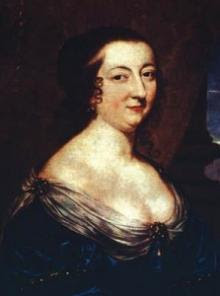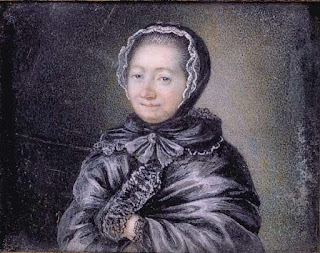Madame Barbot de Villeneuve's La Belle et La Bete: Reflections on the Original Beauty & the Beast Tale
I am not a literary critic, reviewer or smart in literary analysis in any such way. Just to be clear. I love to read, and I love to read Beauty and the Beast tales - in the case you haven't read previous posts. While this project has increased my interest in literary analysis and I'm learning it can be a bottomless hole on the interwebs, for now, I'm keeping posts simple for us plain folk. However, I have found a few analyses and reviews that I respect and will reference them for your edification.
The OG Beauty and the Beast
Reflections on the original - La Belle et La Bête by Madame Gabrielle-Suzanne Barbot de Villeneuve, written 1740:
Did you know that Beauty is the daughter of a fairy!?!
Barbot de Villeneuve,
author of the original Beauty and the Beast- And the Prince's cousin!! /ewww
- Monkeys, parrots and birds attend Beauty while at the enchanted castle.
- The Beast woos Beauty in her dreams, as her "Beloved Unknown." She doesn't fall in love with the Beast! She feels indebted to him for the loot he gave to her and her family.
- Beauty has 11 siblings - 6 brothers and 5 sisters.
- The Beast/Prince is without a name! Well, all of the characters are.
- The Beast is not described in detail - he is fearsome and with an elephant-ish snout.
- There's a Good Fairy and Evil Fairy influence.
- The Beast's mother is not about to let him marry the lowly daughter of a merchant, even though she saved his freakin' life.
- Beauty and the Beast's story is a sub-plot of a deeper, more vicious soap opera in the fairy empire -- which will be an entirely different post... fairy lore in BATB (another hang up... I mean obsession, err... interest, I have).
Shock and awe, fine people, shock and awe. Such a difference from the Beauty and the Beast we are familiar with.
Summary of the Original Beauty and the Beast Fairytale
I was prepared for a simple, moral rich fairy tale. Nope. More like "As the Fairy World Turns."
 |
| from The Blue Fairy Book, illustration by H.J. Ford, 1893 |
You know the kind of juicy plot I'm talking about... there's a Fairy who falls in love with a King and they have a beautiful daughter. But it's forbidden for young fairies to engage themselves to lower beings, so she's a queen on the sly.
But the Evil Fairy, who's just up to no good all the time, rats her out and gets her imprisoned in Fairyland. Then the Evil Fairy tries to steal her man, the King, while inhabiting a neighboring queen's body, but he shows her the hand. So Evil Fairy kidnaps the daughter cuz she mad, yo. Thank goodness the Queen Fairy's sister is a good auntie and steals the girlie to be raised in a safe household... right, the Merchant's.
Meanwhile, back at the ranch, the Prince's Queen Mother (who is sister to the aforementioned King) has a son but is way too busy being a warrior general to raise him, so she asks the Evil Fairy to be his nanny. Right, cuz that makes sense. Well, because Evil Fairy Nanny couldn't convince the King to marry her, she tries to snag the Prince. He's like "Whatever, you're ancient," and the Queen Mother's like "You've got to be kidding!" So Evil Fairy Nanny gets mad and curses the Prince with the form of a beast and a lot of random conditions.
But thank goodness that Auntie Fairy also makes the rounds, cuz she has just the solution to break the curse. And wouldn't you know it involves instructing the Prince to threaten the merchant to bring back a daughter for him to imprison and setting the wheels in motion for Beauty to be that daughter. Per the random conditions, the Beast Prince can't act smart or interested or anything or the curse is permanent. He does like to watch Beauty all the time /cough #EdwardCullen.
Thank goodness Beauty is a kind, insipid sort of soul, who agrees to the marry the Beast due to his generosity and at her father's urging. But did you catch it? They are cousins, of the first degree variety. Oh, and "she liked reading" (that's a real quote from the tale). Oh, and she still loved her adopted father, cuz well, she's Beauty, inside and out.
And yes, there's a happy ending for the good 'ol King, too. Queen Fairy does a favor for the Fairy Empress, thus proving she has mad fairy skillz and gaining her freedom. And so, they all live happily ever after. /whew. #exhaustedanyone?
I know, a tad sarcastic. But I'm reading along, and I'm thinking "did I choose the right story here?" I checked that it was the original version a couple of times. Not that I didn't appreciate all the juicy back story. And fairy drama? Oh, that will be explored.
Overall, I really enjoyed the original tale. I appreciated the complex backstory, intrigue and interesting characters... like Xena the General Warrior Queen. Not a thing in the 1700s, so way to be progressive Friend de Villeneuve. In fact, all of the heroes in the tale are heroines - from the Good Auntie Fairy, her sister the Queen Fairy to Belle. I like Madame's innovative, fantastical ideas, such as the TV-mirror. While concepts of the story, such as the mythology of Pysche and Cupid's love story, were likely discussed in the salons of the time, I like how Madame brought the elements together using strong women and the moral of looking more deeply than appearances.
So, Who Wrote the Beauty and the Beast Fairytale We Know?
Contrary to popular belief and numerous Pinterest posts, Disney did not create the original Beauty & the Beast. Shocking, I know. No, I'm kidding, I did know that. The first BATB was in 1987 - Vincent, you know him? No, no, really, I'm kidding. Though, Vin is great, and there will be a post about him, too, in the future.
 |
| Jeanne-Marie Le Prince de Beaumont 1711 - 1780 |
Stay with me... the popular version of Beauty and the Beast was published by one Madame Jeanne-Marie Le Prince de Beaumont in 1756, who picked up (/cough plagerized) the story not many years after Madame Barbot de Villeneuve's passing, shortened it and re-published it in a book for kids called Magasin des Enfants (Children's Collection). And I was mad about the remake of Footloose.
There are basics of the tale often reflected in retellings that were first set by Madame Barbot de Villeneuve:
- Beauty's father is a wealthy merchant who fell into trouble.
- Beauty is a young, beautiful maiden, good-natured and positive.
- Beast's castle is enchanted with magical caretakers.
- The Beast has a TV mirror of sorts to troll world news (and individuals #EdwardCullenstopstaring)
- The Merchant is picking a rose when accosted by the Beast and promises to return himself. Beauty takes his place willingly.
- Beauty returns to the Beast after visiting her family.
Should you be interested in joining me in the worm hole of literary explanations, reflections and analysis, here are a couple of places to begin your exploration:
The closing line of Madame Barbot de Villeneuve's tale: "They also disseminated copies of it [this marvelous history] throughout the Universe, so that the world at large might never cease to talk of the wonderful adventures of Beauty and the Beast." Indeed. As they should.
Note: As an Amazon Associate I earn from qualifying purchases. Thank you for your support!


Comments
Post a Comment